HI5002 Finance for Business: A Detailed Company Performance Analysis
VerifiedAdded on 2023/03/31
|7
|932
|328
Report
AI Summary
This report provides a comprehensive analysis of CSL's company performance, focusing on its financial strategies, risk management practices, and investment decisions. The analysis includes an examination of systematic and unsystematic risks faced by CSL within the pharmaceutical industry, along with an assessment of the company's profitability and dividend payout ratios from 2016 to 2018. The report concludes by recommending that CSL continue to analyze its investments in research and development to ensure sustainable future growth, highlighting the importance of investment valuation and project appraisal techniques in making informed business decisions.
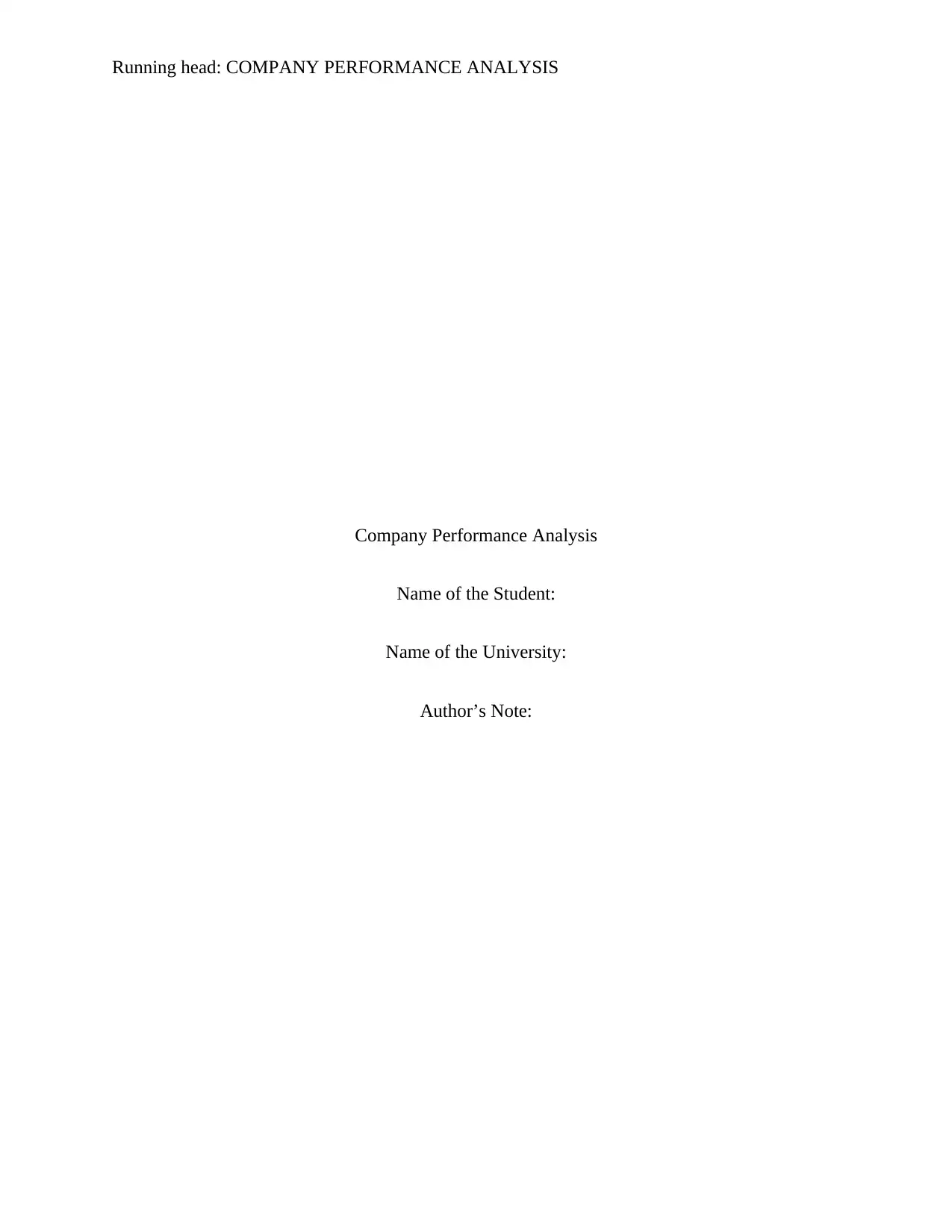
Running head: COMPANY PERFORMANCE ANALYSIS
Company Performance Analysis
Name of the Student:
Name of the University:
Author’s Note:
Company Performance Analysis
Name of the Student:
Name of the University:
Author’s Note:
Paraphrase This Document
Need a fresh take? Get an instant paraphrase of this document with our AI Paraphraser
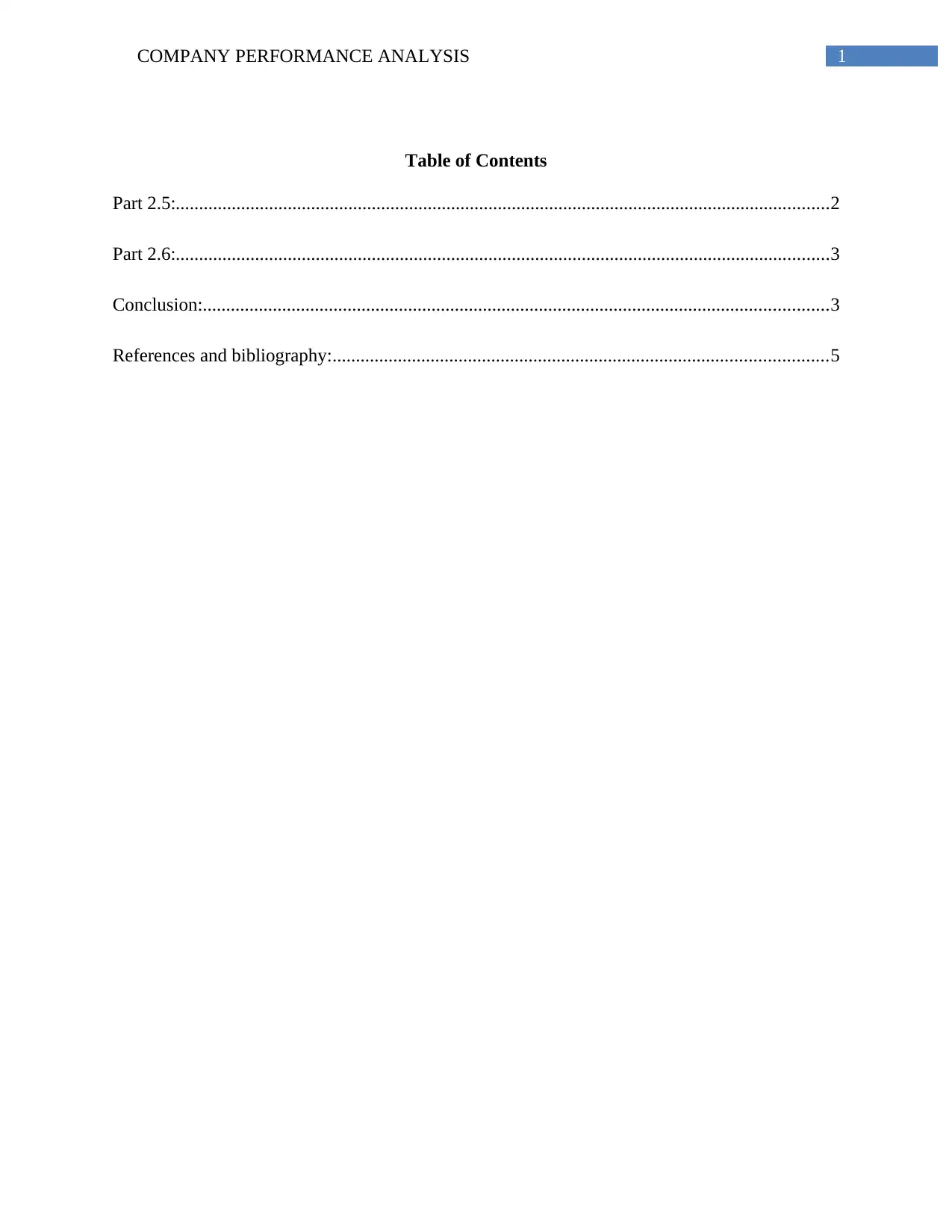
1COMPANY PERFORMANCE ANALYSIS
Table of Contents
Part 2.5:............................................................................................................................................2
Part 2.6:............................................................................................................................................3
Conclusion:......................................................................................................................................3
References and bibliography:..........................................................................................................5
Table of Contents
Part 2.5:............................................................................................................................................2
Part 2.6:............................................................................................................................................3
Conclusion:......................................................................................................................................3
References and bibliography:..........................................................................................................5
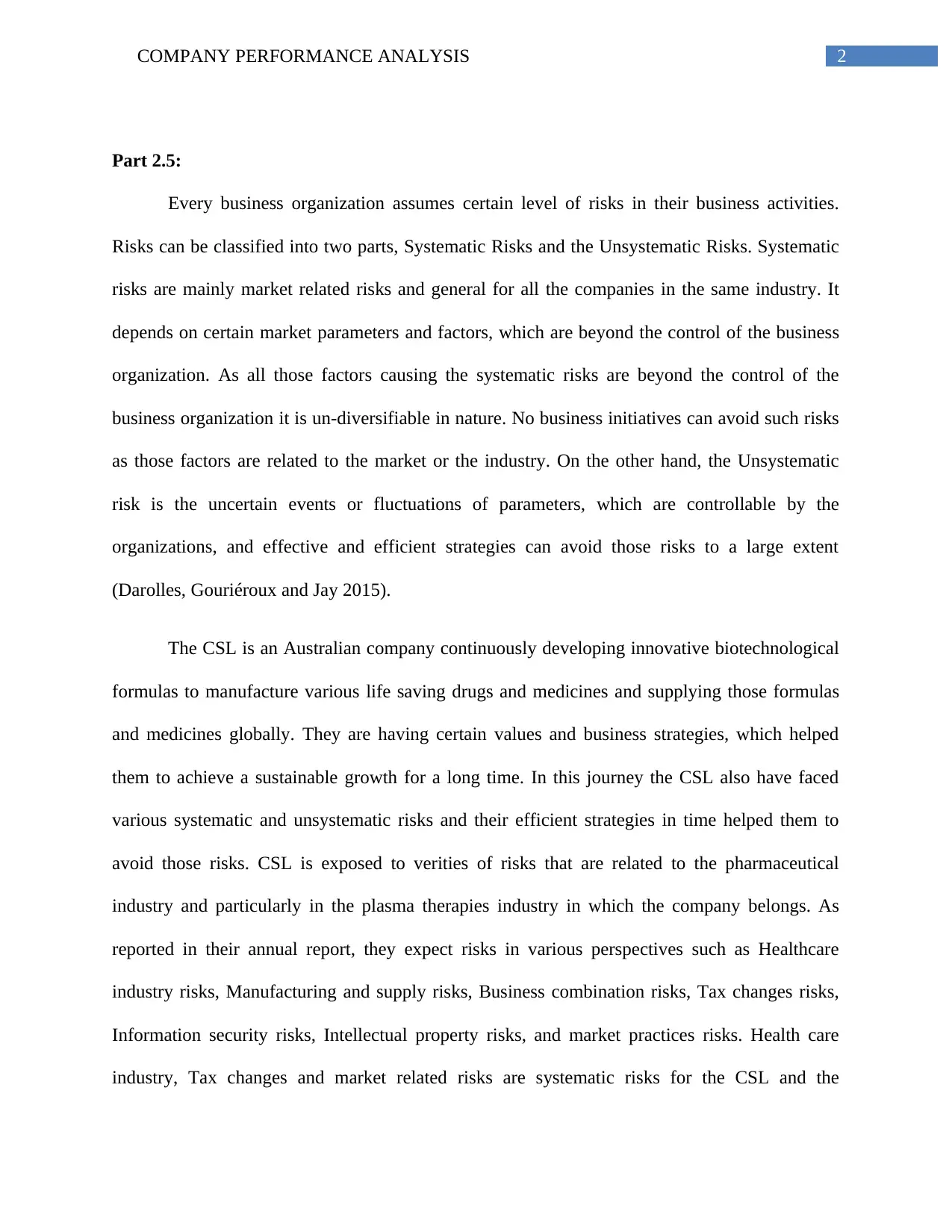
2COMPANY PERFORMANCE ANALYSIS
Part 2.5:
Every business organization assumes certain level of risks in their business activities.
Risks can be classified into two parts, Systematic Risks and the Unsystematic Risks. Systematic
risks are mainly market related risks and general for all the companies in the same industry. It
depends on certain market parameters and factors, which are beyond the control of the business
organization. As all those factors causing the systematic risks are beyond the control of the
business organization it is un-diversifiable in nature. No business initiatives can avoid such risks
as those factors are related to the market or the industry. On the other hand, the Unsystematic
risk is the uncertain events or fluctuations of parameters, which are controllable by the
organizations, and effective and efficient strategies can avoid those risks to a large extent
(Darolles, Gouriéroux and Jay 2015).
The CSL is an Australian company continuously developing innovative biotechnological
formulas to manufacture various life saving drugs and medicines and supplying those formulas
and medicines globally. They are having certain values and business strategies, which helped
them to achieve a sustainable growth for a long time. In this journey the CSL also have faced
various systematic and unsystematic risks and their efficient strategies in time helped them to
avoid those risks. CSL is exposed to verities of risks that are related to the pharmaceutical
industry and particularly in the plasma therapies industry in which the company belongs. As
reported in their annual report, they expect risks in various perspectives such as Healthcare
industry risks, Manufacturing and supply risks, Business combination risks, Tax changes risks,
Information security risks, Intellectual property risks, and market practices risks. Health care
industry, Tax changes and market related risks are systematic risks for the CSL and the
Part 2.5:
Every business organization assumes certain level of risks in their business activities.
Risks can be classified into two parts, Systematic Risks and the Unsystematic Risks. Systematic
risks are mainly market related risks and general for all the companies in the same industry. It
depends on certain market parameters and factors, which are beyond the control of the business
organization. As all those factors causing the systematic risks are beyond the control of the
business organization it is un-diversifiable in nature. No business initiatives can avoid such risks
as those factors are related to the market or the industry. On the other hand, the Unsystematic
risk is the uncertain events or fluctuations of parameters, which are controllable by the
organizations, and effective and efficient strategies can avoid those risks to a large extent
(Darolles, Gouriéroux and Jay 2015).
The CSL is an Australian company continuously developing innovative biotechnological
formulas to manufacture various life saving drugs and medicines and supplying those formulas
and medicines globally. They are having certain values and business strategies, which helped
them to achieve a sustainable growth for a long time. In this journey the CSL also have faced
various systematic and unsystematic risks and their efficient strategies in time helped them to
avoid those risks. CSL is exposed to verities of risks that are related to the pharmaceutical
industry and particularly in the plasma therapies industry in which the company belongs. As
reported in their annual report, they expect risks in various perspectives such as Healthcare
industry risks, Manufacturing and supply risks, Business combination risks, Tax changes risks,
Information security risks, Intellectual property risks, and market practices risks. Health care
industry, Tax changes and market related risks are systematic risks for the CSL and the
⊘ This is a preview!⊘
Do you want full access?
Subscribe today to unlock all pages.

Trusted by 1+ million students worldwide
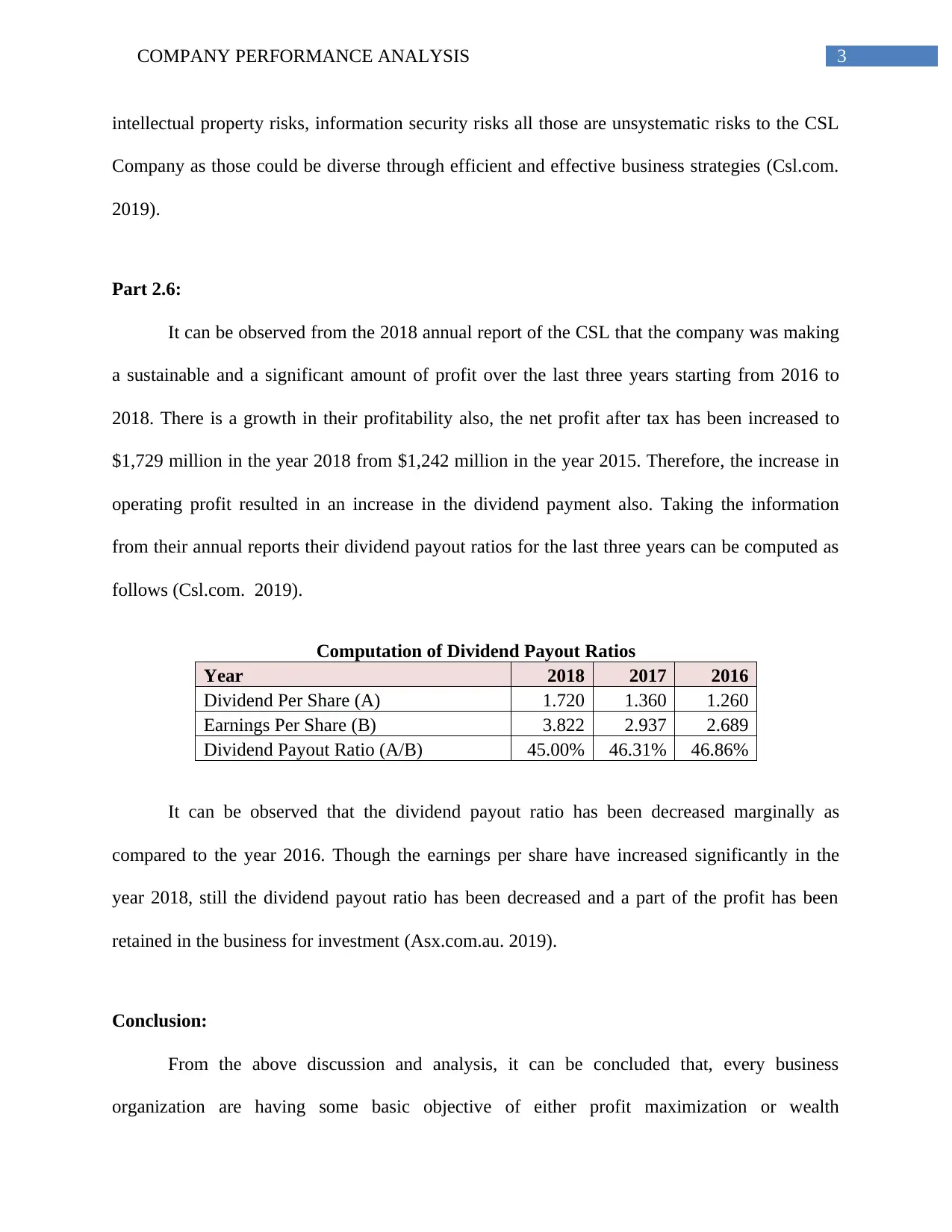
3COMPANY PERFORMANCE ANALYSIS
intellectual property risks, information security risks all those are unsystematic risks to the CSL
Company as those could be diverse through efficient and effective business strategies (Csl.com.
2019).
Part 2.6:
It can be observed from the 2018 annual report of the CSL that the company was making
a sustainable and a significant amount of profit over the last three years starting from 2016 to
2018. There is a growth in their profitability also, the net profit after tax has been increased to
$1,729 million in the year 2018 from $1,242 million in the year 2015. Therefore, the increase in
operating profit resulted in an increase in the dividend payment also. Taking the information
from their annual reports their dividend payout ratios for the last three years can be computed as
follows (Csl.com. 2019).
Computation of Dividend Payout Ratios
Year 2018 2017 2016
Dividend Per Share (A) 1.720 1.360 1.260
Earnings Per Share (B) 3.822 2.937 2.689
Dividend Payout Ratio (A/B) 45.00% 46.31% 46.86%
It can be observed that the dividend payout ratio has been decreased marginally as
compared to the year 2016. Though the earnings per share have increased significantly in the
year 2018, still the dividend payout ratio has been decreased and a part of the profit has been
retained in the business for investment (Asx.com.au. 2019).
Conclusion:
From the above discussion and analysis, it can be concluded that, every business
organization are having some basic objective of either profit maximization or wealth
intellectual property risks, information security risks all those are unsystematic risks to the CSL
Company as those could be diverse through efficient and effective business strategies (Csl.com.
2019).
Part 2.6:
It can be observed from the 2018 annual report of the CSL that the company was making
a sustainable and a significant amount of profit over the last three years starting from 2016 to
2018. There is a growth in their profitability also, the net profit after tax has been increased to
$1,729 million in the year 2018 from $1,242 million in the year 2015. Therefore, the increase in
operating profit resulted in an increase in the dividend payment also. Taking the information
from their annual reports their dividend payout ratios for the last three years can be computed as
follows (Csl.com. 2019).
Computation of Dividend Payout Ratios
Year 2018 2017 2016
Dividend Per Share (A) 1.720 1.360 1.260
Earnings Per Share (B) 3.822 2.937 2.689
Dividend Payout Ratio (A/B) 45.00% 46.31% 46.86%
It can be observed that the dividend payout ratio has been decreased marginally as
compared to the year 2016. Though the earnings per share have increased significantly in the
year 2018, still the dividend payout ratio has been decreased and a part of the profit has been
retained in the business for investment (Asx.com.au. 2019).
Conclusion:
From the above discussion and analysis, it can be concluded that, every business
organization are having some basic objective of either profit maximization or wealth
Paraphrase This Document
Need a fresh take? Get an instant paraphrase of this document with our AI Paraphraser
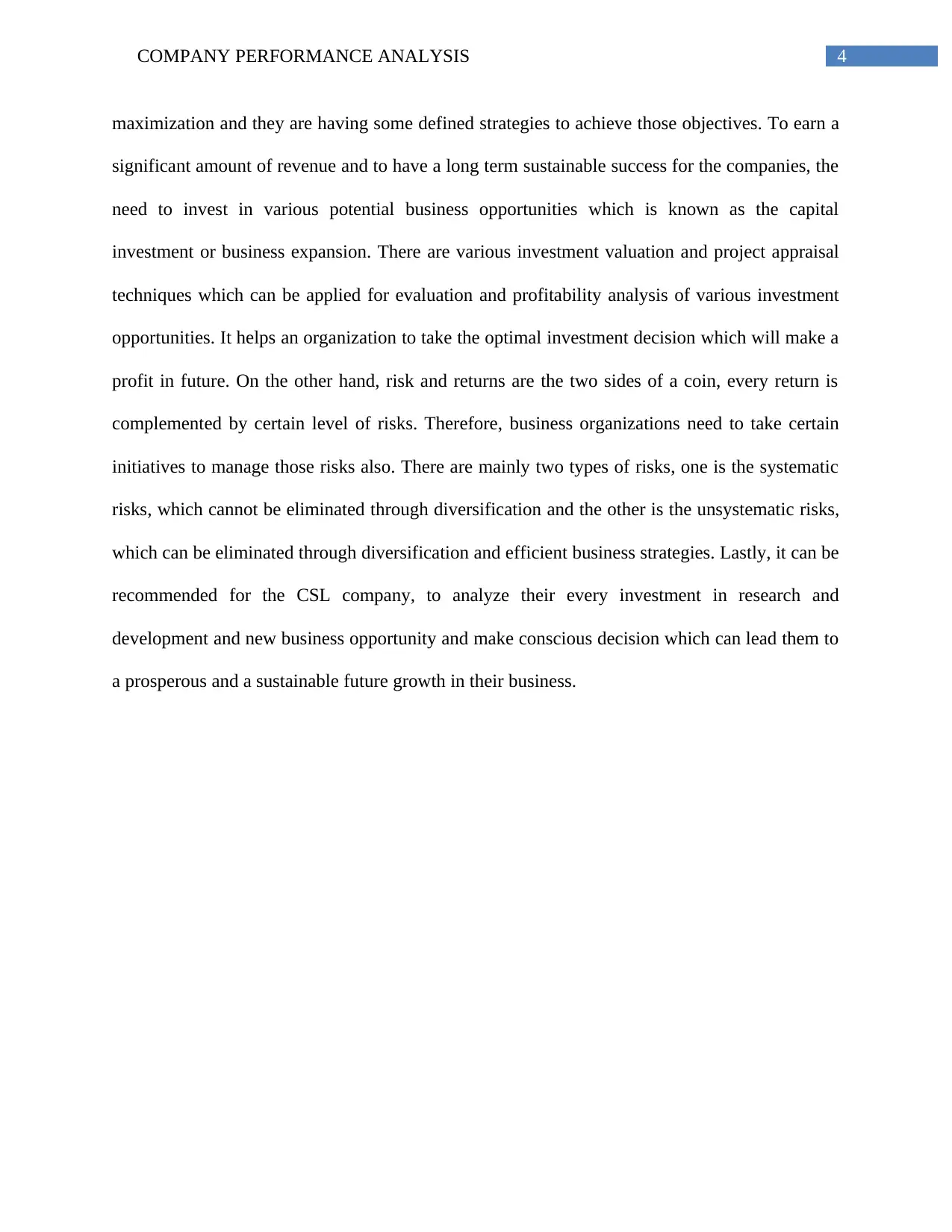
4COMPANY PERFORMANCE ANALYSIS
maximization and they are having some defined strategies to achieve those objectives. To earn a
significant amount of revenue and to have a long term sustainable success for the companies, the
need to invest in various potential business opportunities which is known as the capital
investment or business expansion. There are various investment valuation and project appraisal
techniques which can be applied for evaluation and profitability analysis of various investment
opportunities. It helps an organization to take the optimal investment decision which will make a
profit in future. On the other hand, risk and returns are the two sides of a coin, every return is
complemented by certain level of risks. Therefore, business organizations need to take certain
initiatives to manage those risks also. There are mainly two types of risks, one is the systematic
risks, which cannot be eliminated through diversification and the other is the unsystematic risks,
which can be eliminated through diversification and efficient business strategies. Lastly, it can be
recommended for the CSL company, to analyze their every investment in research and
development and new business opportunity and make conscious decision which can lead them to
a prosperous and a sustainable future growth in their business.
maximization and they are having some defined strategies to achieve those objectives. To earn a
significant amount of revenue and to have a long term sustainable success for the companies, the
need to invest in various potential business opportunities which is known as the capital
investment or business expansion. There are various investment valuation and project appraisal
techniques which can be applied for evaluation and profitability analysis of various investment
opportunities. It helps an organization to take the optimal investment decision which will make a
profit in future. On the other hand, risk and returns are the two sides of a coin, every return is
complemented by certain level of risks. Therefore, business organizations need to take certain
initiatives to manage those risks also. There are mainly two types of risks, one is the systematic
risks, which cannot be eliminated through diversification and the other is the unsystematic risks,
which can be eliminated through diversification and efficient business strategies. Lastly, it can be
recommended for the CSL company, to analyze their every investment in research and
development and new business opportunity and make conscious decision which can lead them to
a prosperous and a sustainable future growth in their business.
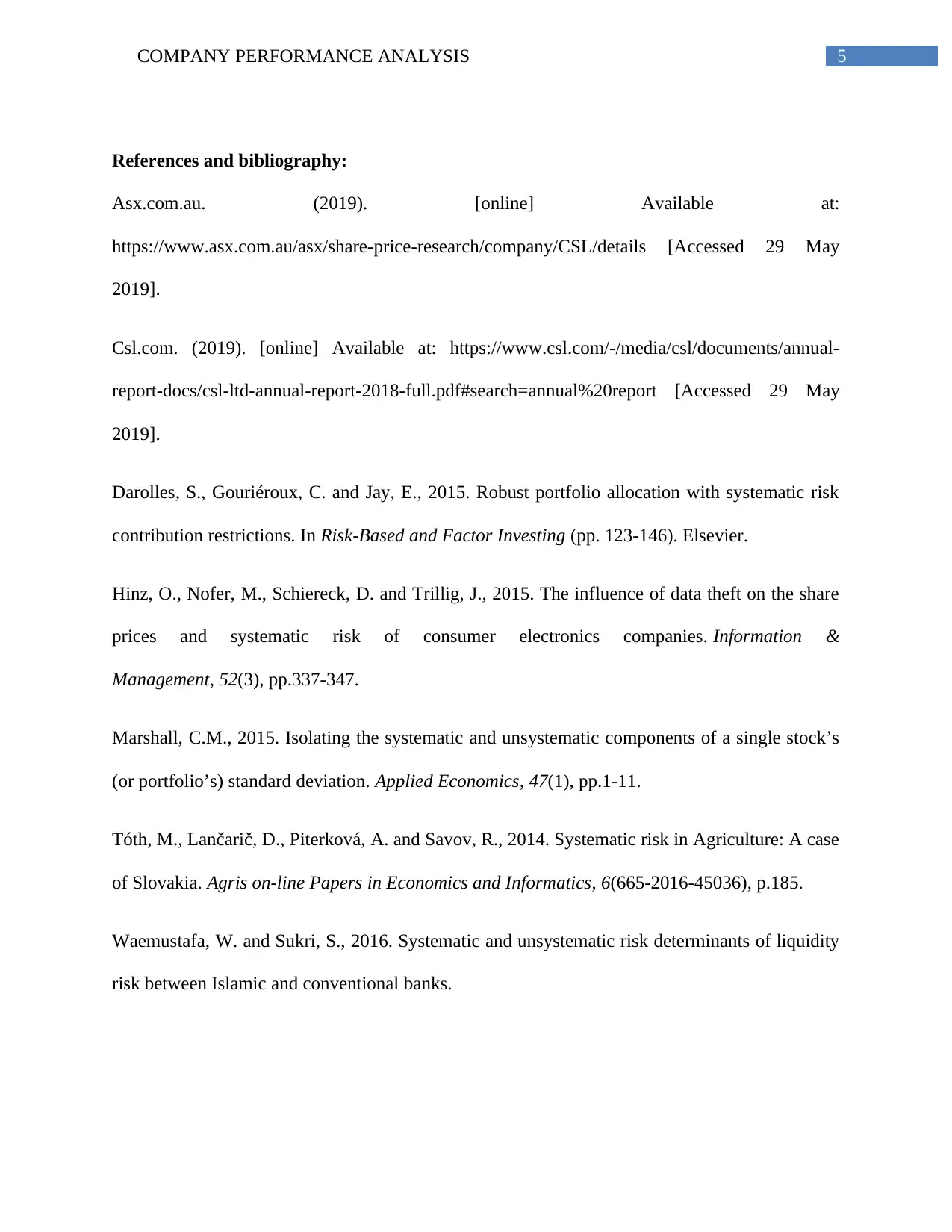
5COMPANY PERFORMANCE ANALYSIS
References and bibliography:
Asx.com.au. (2019). [online] Available at:
https://www.asx.com.au/asx/share-price-research/company/CSL/details [Accessed 29 May
2019].
Csl.com. (2019). [online] Available at: https://www.csl.com/-/media/csl/documents/annual-
report-docs/csl-ltd-annual-report-2018-full.pdf#search=annual%20report [Accessed 29 May
2019].
Darolles, S., Gouriéroux, C. and Jay, E., 2015. Robust portfolio allocation with systematic risk
contribution restrictions. In Risk-Based and Factor Investing (pp. 123-146). Elsevier.
Hinz, O., Nofer, M., Schiereck, D. and Trillig, J., 2015. The influence of data theft on the share
prices and systematic risk of consumer electronics companies. Information &
Management, 52(3), pp.337-347.
Marshall, C.M., 2015. Isolating the systematic and unsystematic components of a single stock’s
(or portfolio’s) standard deviation. Applied Economics, 47(1), pp.1-11.
Tóth, M., Lančarič, D., Piterková, A. and Savov, R., 2014. Systematic risk in Agriculture: A case
of Slovakia. Agris on-line Papers in Economics and Informatics, 6(665-2016-45036), p.185.
Waemustafa, W. and Sukri, S., 2016. Systematic and unsystematic risk determinants of liquidity
risk between Islamic and conventional banks.
References and bibliography:
Asx.com.au. (2019). [online] Available at:
https://www.asx.com.au/asx/share-price-research/company/CSL/details [Accessed 29 May
2019].
Csl.com. (2019). [online] Available at: https://www.csl.com/-/media/csl/documents/annual-
report-docs/csl-ltd-annual-report-2018-full.pdf#search=annual%20report [Accessed 29 May
2019].
Darolles, S., Gouriéroux, C. and Jay, E., 2015. Robust portfolio allocation with systematic risk
contribution restrictions. In Risk-Based and Factor Investing (pp. 123-146). Elsevier.
Hinz, O., Nofer, M., Schiereck, D. and Trillig, J., 2015. The influence of data theft on the share
prices and systematic risk of consumer electronics companies. Information &
Management, 52(3), pp.337-347.
Marshall, C.M., 2015. Isolating the systematic and unsystematic components of a single stock’s
(or portfolio’s) standard deviation. Applied Economics, 47(1), pp.1-11.
Tóth, M., Lančarič, D., Piterková, A. and Savov, R., 2014. Systematic risk in Agriculture: A case
of Slovakia. Agris on-line Papers in Economics and Informatics, 6(665-2016-45036), p.185.
Waemustafa, W. and Sukri, S., 2016. Systematic and unsystematic risk determinants of liquidity
risk between Islamic and conventional banks.
⊘ This is a preview!⊘
Do you want full access?
Subscribe today to unlock all pages.

Trusted by 1+ million students worldwide
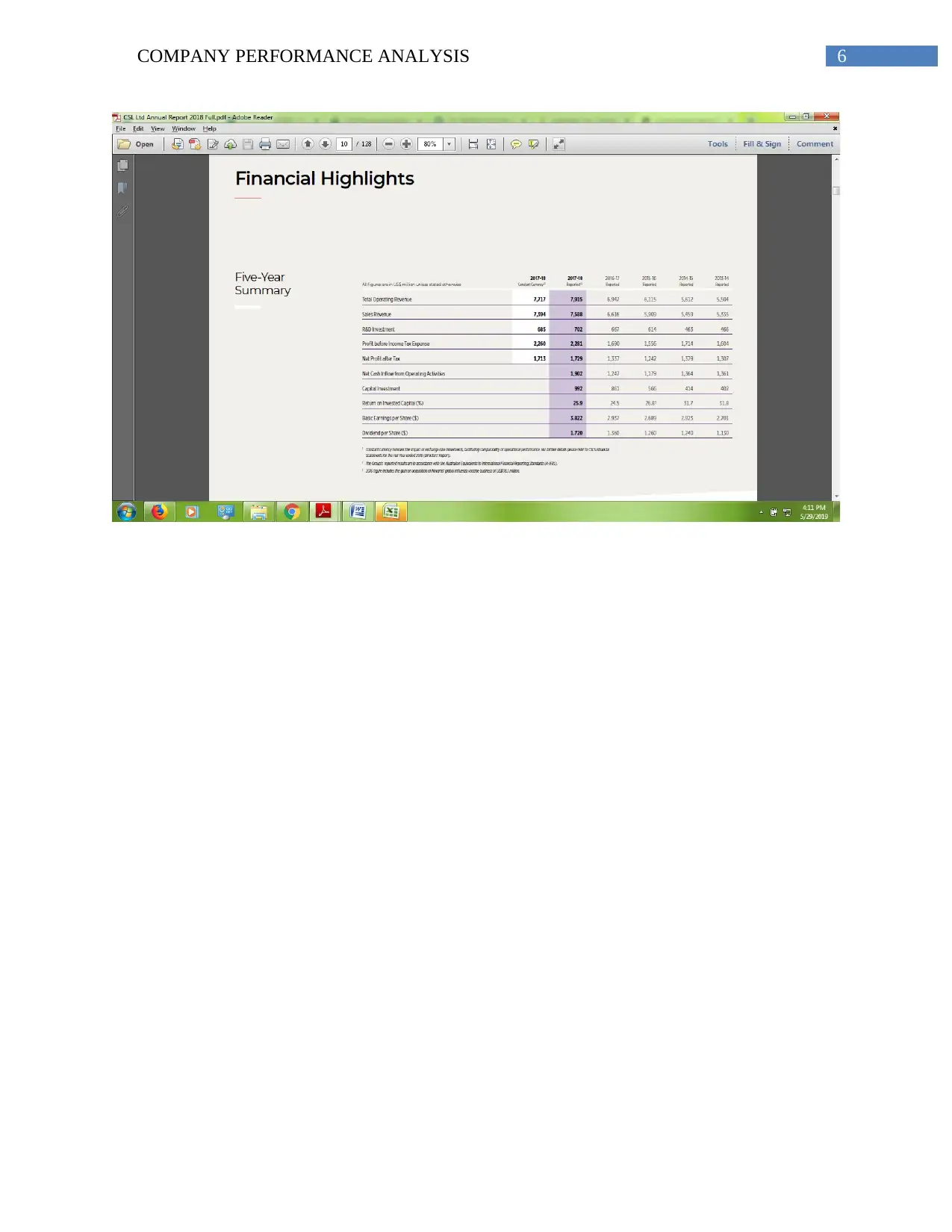
6COMPANY PERFORMANCE ANALYSIS
1 out of 7
Related Documents
Your All-in-One AI-Powered Toolkit for Academic Success.
+13062052269
info@desklib.com
Available 24*7 on WhatsApp / Email
![[object Object]](/_next/static/media/star-bottom.7253800d.svg)
Unlock your academic potential
Copyright © 2020–2025 A2Z Services. All Rights Reserved. Developed and managed by ZUCOL.





